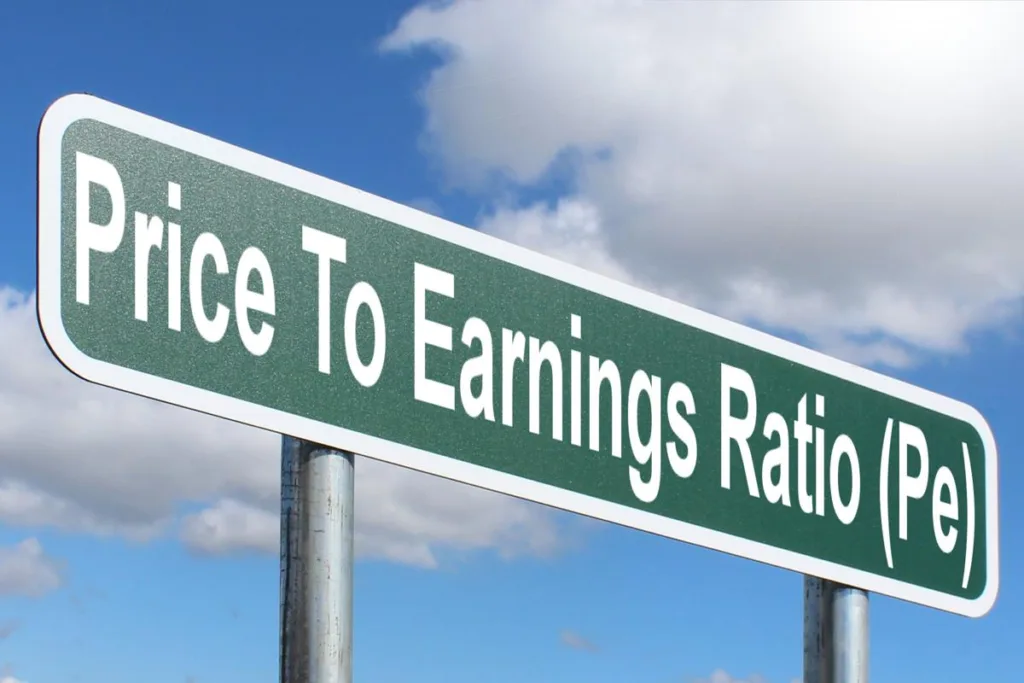The Price-to-Earnings (P/E) ratio is a fundamental tool used by investors to evaluate the valuation of a company’s stock. It provides insights into the market’s perception of a company’s future earnings potential and is widely employed in financial analysis.

In this blog post, we will delve into the intricacies of the P/E ratio, including what it is, how to calculate it, the different types, how to read and interpret it, its benefits, limitations, and how to perform P/E ratio analysis.
What is P/E Ratio?
The P/E ratio is one of the most important financial ratios and a financial metric that measures the relationship between a company’s stock price and its earnings per share (EPS). It is calculated by dividing the CMP per share by the EPS.
The P/E ratio may be computed using the following formula:
The P/E ratio = Market price per share / Earnings per share (EPS).
The resulting ratio represents the number of times investors are willing to pay for each dollar of earnings generated by the company. For example, a P/E ratio of 20 indicates that investors are willing to pay $20 for every $1 of earnings.
How to Calculate P/E Ratio
Calculating the P/E ratio requires obtaining two key pieces of information: the market price per share and the earnings per share (EPS). The market price per share is readily available from financial websites or brokerage platforms. The EPS can be found in a company’s financial statements or estimated based on analyst reports.
Once you have these values, divide the market price per share by the EPS to obtain the P/E ratio.
Different Types of P/E Ratios
There are two main types of P/E ratios: trailing P/E ratio and forward P/E ratio.
Trailing P/E Ratio
The trailing P/E ratio, also known as historical P/E ratio, uses the actual earnings from the past twelve months to calculate the ratio. It provides insight into how much investors are willing to pay for a company’s most recent earnings.
Forward P/E Ratio
The forward P/E ratio relies on estimated future earnings rather than historical earnings. Analysts use their projections to determine the expected earnings per share for the coming twelve months. This type of P/E ratio gives investors an idea of how much they are paying for anticipated future earnings.
How to Read and Interpret P/E Ratio
Understanding how to read and interpret the P/E ratio is essential for effective investment decision-making. The following aspects must be considered before making any decisions :
High P/E Ratio
A high P/E ratio suggests that investors have high expectations for future growth or earnings from the company. Companies with high-growth prospects, innovative technologies, or strong market positions often have higher P/E ratios. However, a high P/E ratio may also indicate an overvalued stock.
Growth Potential: Often, high P/E ratios are associated with growth stocks, particularly in innovative sectors like technology. Investors are betting on these companies outpacing the market with future earnings, justifying the premium valuation.
Overvaluation Risk: However, a high P/E ratio can also indicate overvaluation. If future earnings growth fails to materialize, the stock price may plummet, leaving investors with significant losses. This risk is amplified in volatile markets.
Low P/E Ratio
A stock’s price-to-earnings (P/E) ratio is a beacon for value investors, but a low P/E ratio can be both a treasure map and a red herring. While it suggests a potentially undervalued stock, careful examination is needed to separate hidden gems from duds. Let’s embark on a quest to decipher the true meaning of a low P/E in today’s market:
The Value Proposition:
Lower Price, Higher Earnings: A low P/E indicates that investors are paying less for each dollar of a company’s current earnings. This could suggest an undervalued stock with the potential for price appreciation as the market recognizes its true worth.
Value Stocks: Low P/E stocks are often classified as value stocks, known for their stable dividends and lower volatility compared to high-growth counterparts. However, lower growth potential is often the trade-off.
Beyond the Surface:
Digging Deeper: Don’t be lured by the low price tag alone. Investigate the reasons behind the low P/E. Is it due to temporary setbacks, industry decline, or company-specific issues? Understanding the cause is crucial before investing.
Financial Health: Scrutinize the company’s financial health. Are there hidden debts, declining profitability, or weak management? A low P/E due to financial struggles might not signal a bargain, but rather a sinking ship.
Context is King:
Industry Comparison: Compare the P/E ratio to the industry average and the company’s historical P/E range. A low P/E within a high-growth industry might be more concerning than in a mature, slower-growth sector.
Future Potential: While low P/E suggests value, assess the company’s future growth prospects. Are there new products, strong market positioning, or innovative strategies that could unlock hidden potential?
Beyond the P/E:
PEG Ratio: Consider the price-to-earnings-to-growth (PEG) ratio, which factors in expected earnings growth. A high PEG ratio with a low P/E could indicate overvaluation if future growth is uncertain.
Qualitative Factors: Don’t forget about qualitative aspects like brand strength, management competency, and competitive landscape. These can significantly impact future earnings and justify a low P/E.
Remember:
A low P/E ratio is a starting point, not a guaranteed path to riches. Comprehensive research that considers industry context, financial health, growth prospects, and qualitative factors is essential before investing based solely on P/E. In the market’s ever-shifting sands, carefully interpreting a low P/E ratio equips you to uncover true value and make informed investment decisions.
Industry Comparison
Comparing a company’s P/E ratio to its industry peers can provide valuable insights. If a company has a significantly higher or lower P/E ratio compared to its peers, it may indicate unique factors that warrant further investigation.
Historical Comparison
Analyzing a company’s historical P/E ratios can help identify trends and deviations from the norm. Significant changes in the P/E ratio over time may signal shifts in investor sentiment or changes in the company’s growth trajectory.
Benefits of Using P/E Ratio
The P/E ratio offers several benefits for investors and analysts:
Valuation Tool
The P/E ratio serves as a valuation tool, enabling investors to assess whether a stock is overvalued or undervalued relative to its earnings potential. It provides a quantitative measure of market sentiment towards a company’s future prospects.
Comparability
By using the P/E ratio, investors can compare companies within the same industry or across different sectors. This allows for relative valuation analysis and helps identify companies with attractive investment opportunities.
Forecasting Potential Returns
The P/E ratio can also assist in estimating potential returns on investment. By comparing a company’s current P/E ratio with its historical averages or industry benchmarks, investors can gauge whether the stock has room for appreciation or may be overpriced.
Limitations of P/E Ratio
While the P/E ratio is a widely-used metric, it has certain limitations that investors should be aware of:
Industry Differences
Different sectors have varied degrees of profitability and development potential. Comparing the P/E ratios of companies in different sectors may not provide an accurate basis for evaluation.
Earnings Manipulation
Some companies may manipulate their earnings figures to artificially inflate or deflate the P/E ratio. Investors should exercise caution and consider additional financial metrics when analyzing such companies.
Lack of Context
The P/E ratio alone does not provide a complete picture of a company’s financial health. It is crucial to consider other factors such as debt levels, cash flows, competitive landscape, and management quality when making investment decisions.
Performing P/E Ratio Analysis
Performing thorough analysis using the P/E ratio involves a comprehensive evaluation of various factors. Here are some steps to consider:
1. Research and gather financial data for the company.
2. Calculate both the trailing and forward P/E ratios.
3. Compare the calculated ratios to industry peers and historical averages.
4. Analyze any significant deviations from industry norms or historical trends.
5. Investigate factors that may impact future earnings potential.
6. Consider other financial metrics and qualitative aspects to form a holistic view.
Drawing P/E Ratio Comparisons
Drawing comparisons between different companies’ P/E ratios can provide valuable insights into relative valuations and investment opportunities.
1. Select a group of companies within the same industry or sector.
2. Gather their respective market prices per share and earnings per share.
3. Calculate the trailing or forward P/E ratios for each company.
4. Plot the calculated ratios on a graph or table for visual comparison.
5. Analyze any significant differences or trends among the companies.
6. Consider qualitative factors alongside the quantitative analysis for a comprehensive understanding.
Conclusion
The Price-to-Earnings (P/E) ratio is a powerful tool used by investors to assess a company’s valuation and growth potential. Understanding how to calculate, read, and interpret this metric can help investors make informed decisions when evaluating investment opportunities. By considering its benefits and limitations while performing thorough analysis, investors can gain valuable insights into companies’ financial health and market perception.
Frequently Asked Questions (FAQs)
1. Q: Can a negative P/E ratio be valid?
A: Yes, a negative P/E ratio may occur when a company reports negative earnings. It suggests that currently the company is not being able to generate profits.
2. Q: Is a higher P/E ratio always better?
A: Not necessarily. While a higher P/E ratio may indicate growth potential, it can also suggest an overvalued stock. Other factors should be considered when interpreting the ratio.
3. Q: Can I use the P/E ratio as the sole basis for investment decisions?
A: No, it is advisable to consider other financial metrics, industry dynamics, competitive landscape, and qualitative aspects alongside the P/E ratio before making investment decisions.
4. Q: What are some other valuation metrics apart from the P/E ratio?
A: Other common valuation metrics include Price/Sales (P/S) ratio, Price/Book (P/B) ratio, Dividend Yield, and Free Cash Flow (FCF) yield.
5. Q: How frequently should I monitor the P/E ratios of my investments?
A: It is generally recommended to review and update your analysis periodically, considering any new financial information or changes in market conditions.
Q6: What does a high P/E Ratio indicate?
A6: A high P/E Ratio suggests that investors are willing to pay a premium for each unit of earnings generated by the company. It may indicate high growth expectations or overvaluation.
Q7: Is a low P/E Ratio always better?
A7: Not necessarily. While a low P/E Ratio may indicate undervaluation, it could also suggest potential risks or challenges facing the company. It is essential to evaluate other factors alongside the ratio.
Q8: Can I compare the P/E Ratios of companies in different industries?
A8: While comparing P/E Ratios across industries can provide some insights, it is important to consider industry-specific factors such as growth potential and risk profiles when making comparisons.
Reference : http://www.fools.com







